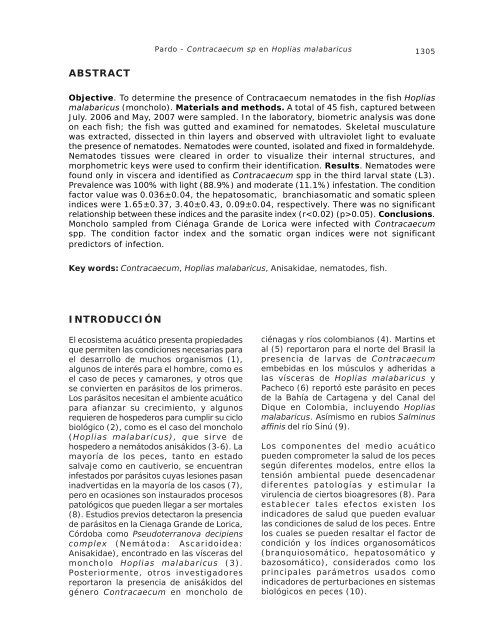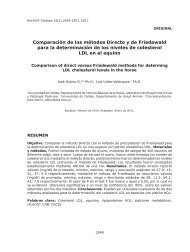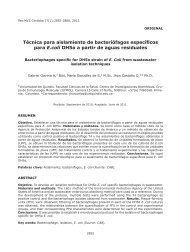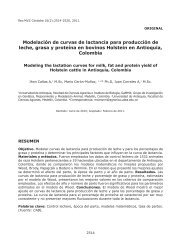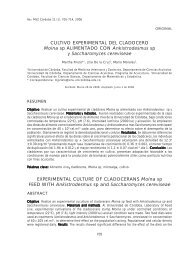Contracaecum sp (ANISAKIDAE) EN EL PEZ Hoplias malabaricus
Contracaecum sp (ANISAKIDAE) EN EL PEZ Hoplias malabaricus
Contracaecum sp (ANISAKIDAE) EN EL PEZ Hoplias malabaricus
You also want an ePaper? Increase the reach of your titles
YUMPU automatically turns print PDFs into web optimized ePapers that Google loves.
ABSTRACT<br />
1305<br />
Objective. To determine the presence of <strong>Contracaecum</strong> nematodes in the fish <strong>Hoplias</strong><br />
<strong>malabaricus</strong> (moncholo). Materials and methods. A total of 45 fish, captured between<br />
July. 2006 and May, 2007 were sampled. In the laboratory, biometric analysis was done<br />
on each fish; the fish was gutted and examined for nematodes. Skeletal musculature<br />
was extracted, dissected in thin layers and observed with ultraviolet light to evaluate<br />
the presence of nematodes. Nematodes were counted, isolated and fixed in formaldehyde.<br />
Nematodes tissues were cleared in order to visualize their internal structures, and<br />
morphometric keys were used to confirm their identification. Results. Nematodes were<br />
found only in viscera and identified as <strong>Contracaecum</strong> <strong>sp</strong>p in the third larval state (L3).<br />
Prevalence was 100% with light (88.9%) and moderate (11.1%) infestation. The condition<br />
factor value was 0.036±0.04, the hepatosomatic, branchiasomatic and somatic <strong>sp</strong>leen<br />
indices were 1.65±0.37, 3.40±0.43, 0.09±0.04, re<strong>sp</strong>ectively. There was no significant<br />
relationship between these indices and the parasite index (r0.05). Conclusions.<br />
Moncholo sampled from Ciénaga Grande de Lorica were infected with <strong>Contracaecum</strong><br />
<strong>sp</strong>p. The condition factor index and the somatic organ indices were not significant<br />
predictors of infection.<br />
Key words: <strong>Contracaecum</strong>, <strong>Hoplias</strong> <strong>malabaricus</strong>, Anisakidae, nematodes, fish.<br />
INTRODUCCIÓN<br />
Pardo - <strong>Contracaecum</strong> <strong>sp</strong> en <strong>Hoplias</strong> <strong>malabaricus</strong><br />
El ecosistema acuático presenta propiedades<br />
que permiten las condiciones necesarias para<br />
el desarrollo de muchos organismos (1),<br />
algunos de interés para el hombre, como es<br />
el caso de peces y camarones, y otros que<br />
se convierten en parásitos de los primeros.<br />
Los parásitos necesitan el ambiente acuático<br />
para afianzar su crecimiento, y algunos<br />
requieren de ho<strong>sp</strong>ederos para cumplir su ciclo<br />
biológico (2), como es el caso del moncholo<br />
(<strong>Hoplias</strong> <strong>malabaricus</strong>), que sirve de<br />
ho<strong>sp</strong>edero a nemátodos anisákidos (3-6). La<br />
mayoría de los peces, tanto en estado<br />
salvaje como en cautiverio, se encuentran<br />
infestados por parásitos cuyas lesiones pasan<br />
inadvertidas en la mayoría de los casos (7),<br />
pero en ocasiones son instaurados procesos<br />
patológicos que pueden llegar a ser mortales<br />
(8). Estudios previos detectaron la presencia<br />
de parásitos en la Cienaga Grande de Lorica,<br />
Córdoba como Pseudoterranova decipiens<br />
complex (Nemátoda: Ascaridoidea:<br />
Anisakidae), encontrado en las vísceras del<br />
moncholo <strong>Hoplias</strong> <strong>malabaricus</strong> (3).<br />
Posteriormente, otros investigadores<br />
reportaron la presencia de anisákidos del<br />
género <strong>Contracaecum</strong> en moncholo de<br />
ciénagas y ríos colombianos (4). Martins et<br />
al (5) reportaron para el norte del Brasil la<br />
presencia de larvas de <strong>Contracaecum</strong><br />
embebidas en los músculos y adheridas a<br />
las vísceras de <strong>Hoplias</strong> <strong>malabaricus</strong> y<br />
Pacheco (6) reportó este parásito en peces<br />
de la Bahía de Cartagena y del Canal del<br />
Dique en Colombia, incluyendo <strong>Hoplias</strong><br />
<strong>malabaricus</strong>. Asímismo en rubios Salminus<br />
affinis del río Sinú (9).<br />
Los componentes del medio acuático<br />
pueden comprometer la salud de los peces<br />
según diferentes modelos, entre ellos la<br />
tensión ambiental puede desencadenar<br />
diferentes patologías y estimular la<br />
virulencia de ciertos bioagresores (8). Para<br />
establecer tales efectos existen los<br />
indicadores de salud que pueden evaluar<br />
las condiciones de salud de los peces. Entre<br />
los cuales se pueden resaltar el factor de<br />
condición y los índices organosomáticos<br />
(branquiosomático, hepatosomático y<br />
bazosomático), considerados como los<br />
principales parámetros usados como<br />
indicadores de perturbaciones en sistemas<br />
biológicos en peces (10).


